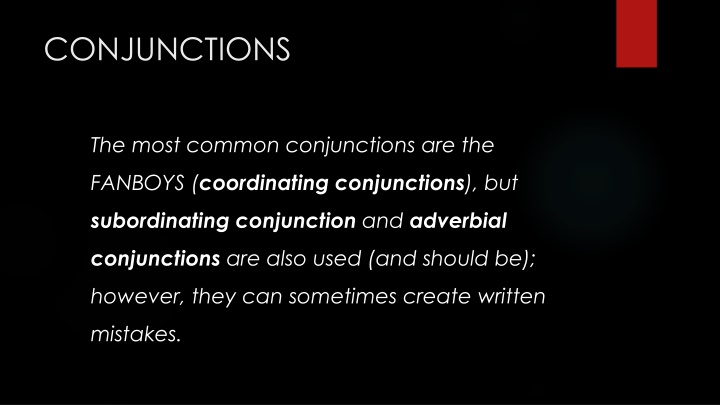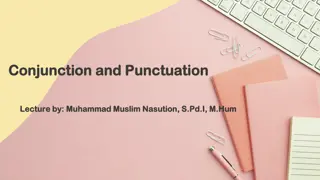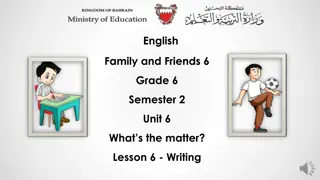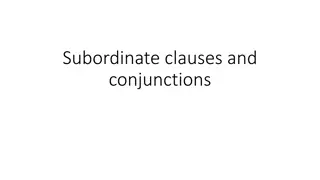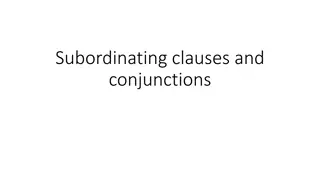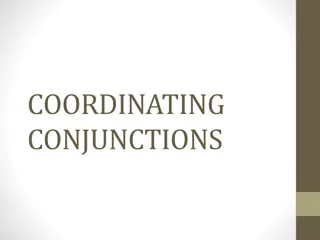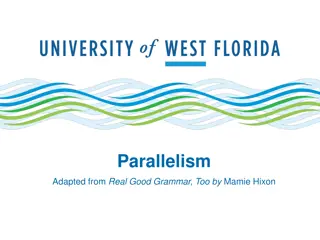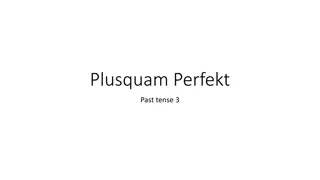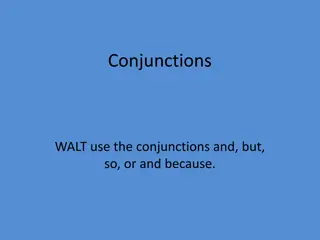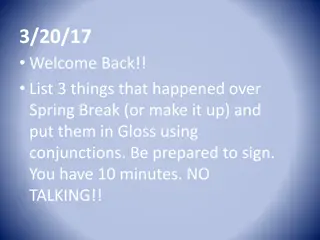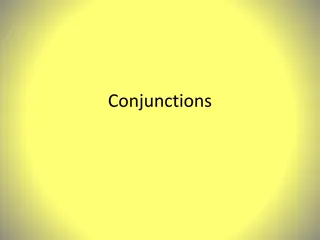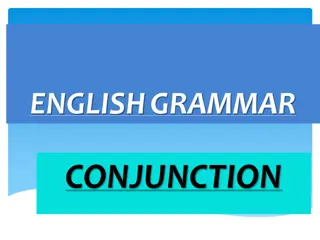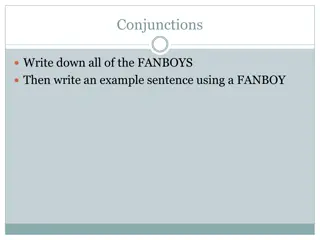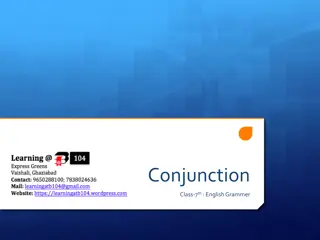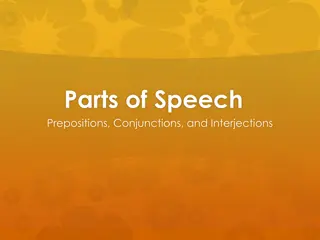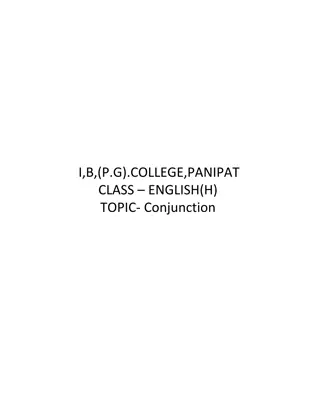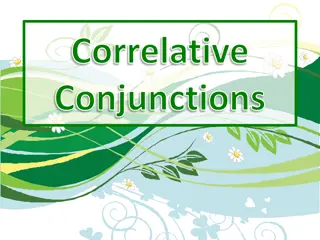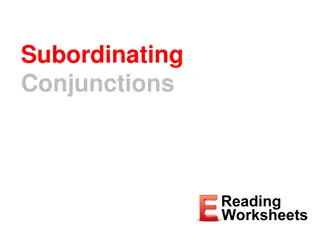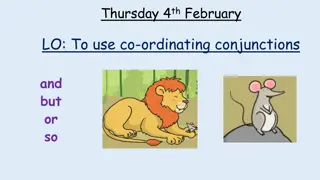Mastering Conjunctions in Writing: Tips and Examples
Learn about the different types of conjunctions - coordinating, subordinating, and adverbial conjunctions - along with helpful writing tips and examples for using them correctly in sentences. Understand common mistakes to avoid and enhance the flow and clarity of your writing with conjunction usage.
Download Presentation

Please find below an Image/Link to download the presentation.
The content on the website is provided AS IS for your information and personal use only. It may not be sold, licensed, or shared on other websites without obtaining consent from the author.If you encounter any issues during the download, it is possible that the publisher has removed the file from their server.
You are allowed to download the files provided on this website for personal or commercial use, subject to the condition that they are used lawfully. All files are the property of their respective owners.
The content on the website is provided AS IS for your information and personal use only. It may not be sold, licensed, or shared on other websites without obtaining consent from the author.
E N D
Presentation Transcript
CONJUNCTIONS The most common conjunctions are the FANBOYS (coordinating conjunctions), but subordinating conjunction and adverbial conjunctions are also used (and should be); however, they can sometimes create written mistakes.
#10 FANBOYS -------------CONJUNCTION WRITING TIPS AND SUGGESTIONS---------- The mistake kids often make with regards to FANBOYS use is comma placement. It is NOT a rule to always place a comma before and , which is the most common of the FANBOYS. Commas do go before the and when: Using a list of three or more Ex. Bob, Jack, and Phil I went running, skiing, and swimming last week. When connecting two independent clauses (two sentences) Ex. John did all of his homework, but Sue did none of hers. Today had the most pleasant weather, yet tomorrow it calls for rain.
#10 ADVERBIAL CONJUNCTIONS Adverbial Conjunctions- join complete thoughts (like the FANBOYS) but go further by articulating relationship between ideas/sentences The use of AC s allows a writer to create a flow within a paragraph. Ex. I like chocolate; he likes vanilla. add an AC, to clarify relationship
#10 HOTSHOTCAT ; however, = nevertheless/ in contrast ; otherwise, = alternatively ; therefore, = for that reason ; similarly, = in the same way ; hence, = same as therefore ; on the other hand, = contrast ; then, = next ; consequently, = as a result ; also, = in addition to ; thus, = as a result
#10 HOTSHOTCAT Additional adverbial conjunctions include: accordingly, besides, finally, for example, furthermore, in fact, instead, meanwhile, moreover, nevertheless, now, and soon. Best used after a semi-colon (when separating sentences) and followed by a comma.
#10 an 8thgrade review What is a subordinate conjunction what does subordinate mean? How many of the subordinate conjunctions (aka AAAWWWUUBBIS) can you list? What makes a clause a clause? What differentiates an independent and dependent clause? What is IC DC called? How are the various ways it s punctuated? Stylistically, why would you choose to use these?
#10 subordinating conjunctions and dependent clauses A subordinating conjunction (SC) subordinates a clause (makes it less important) then joins it with an independent clause.
#10 AAAWWWUUBBIS Dependent clauses can often be identified by the use the most common subordinate conjunctions. as although after when(ever) while whether until unless because before if since
#10 subordinating conjunctions and dependent clauses All clauses contain a subject and a verb. Some are independent while some are dependent. This leads to one mechanics mistake.
#10 Fragment Mistakes While we as 9th graders do not create elementary level fragments, the misunderstanding of subordinating conjunctions does cause errors to be made. Ex. Provided the teacher scored the essays. Although he had been a decorated soldier during World War II and had fought many battles for the losing cause of liberalism in Congress. Since the beginning of time and because individuals tend to demonstrate selfish tendencies.
#10 DEPENDENT CLAUSES Dependent clauses added to independent clauses in order to help to clarify and/or add detail. Stylistically, this creates sentence variety a complex sentence (think simple, compound, and complex) Create sophisticated transitions.
#10 DEPENDENT CLAUSES The use of a DC, IC serves as an example of a sophisticated transition between paragraphs in your writing. Which sounds better? The next reason the book should stay on the summer reading list is its relatable characters. While the historical context provides a unique perspective, the characters are also relatable.
#10 DEPENDENT CLAUSES Dependent clauses may appear at the beginning, middle, or end of a sentence which can lead to punctuation mistakes.
#10 DEPENDENT Clause Where would you place the comma in the following example? Since it was raining we decided to go to the movies.
#10 DEPENDENT Clause Where would you place the comma in the following example? DC Since it was raining, we decided to go to the movies. S V RULE: When a dependent clause is placed at the beginning of a sentence, place a comma between the independent clause and the dependent clause.
#10 Dependent clause Where would you place the comma in the following example? We decided to go to the movies because we were bored.
#10 Dependent clause Where would you place the comma in the following example? S V We decided to go to the movies because we were bored. DC RULE: When a dependent clause is located after an independent clause, DO NOT place a comma between the two.
#10 DEPENDENT CLAUSE Where would you place the comma in the following example? Jerry felt since he was old enough he would see the scary movie.
#10 DEPENDENT CLAUSE Where would you place the comma in the following example? S V DC Jerry felt, since he was old enough, he would see the scary movie. RULE: When a dependent clause is located inside an independent clause, place commas around it.
ESSENTIAL KNOWLEDGE #10 IC , Coordinating Conjunction (FANBOYS) IC. (creates a compound sentence) Not IC,IC (comma splice) #1,#2 ,Coordinating Conjunction (FANBOYS) #3 (list) IC ; Adverbial Conjunction (HOTSHOTCAT), IC. Great for flow. DC (grade level fragments) - created by a subordinate conjunction (SC or AAAWWWUUBBIS) DC , IC. And I, DC, C. Not IC, DC. (creates a complex sentence great for transitions)
Essential knowledge #10 Terms Simple Compound Complex Clause DC and IC Comma Splice CC (coordinate) SC (subordinate) AC (adverbial) Grade level Fragments fanboys hot shot cat aaawwwuubbis Punct. Rules item 1 item 2 CC item3. ICIC. IC CC IC. IC DC. DC IC. I DC C. IC AC IC. Rationales sentencevariety transition flow
Background Understanding Define a clause. What is the structure for a compound sentence? Which HOTSHOTCAT means as a result ? Break down the following sentence: draw a vertical line between the two clauses and label each (IC or DC). Circle the subject and underline the verb of each clause, and identify each of the conjunctions and types. 1. 2. 3. 4. Since I appreciate kindness, I gave money to the charity. Joey decided to play, but Mike chose to go home instead. The machine was out of candy; therefore, we went to Wawa.
Transfer #10 to writing Rewrite the paragraph below making changes to improve the flow. Punctuate accordingly. To do so, include two complex sentences, one compound sentence, and one HOTSHOTCAT. Thanksgiving. The idea of turkey, the Macy s parade, and all- day football is too much to pass up. I love seeing family the most. We all gather for the day at my mother s house. It s close to everyone. We eat all day long. We might also play cards or football. Sometimes we usually shop the next day. It is a great time while giving thanks for all of the blessings we have. Halloween is fun. My favorite holiday is easily
